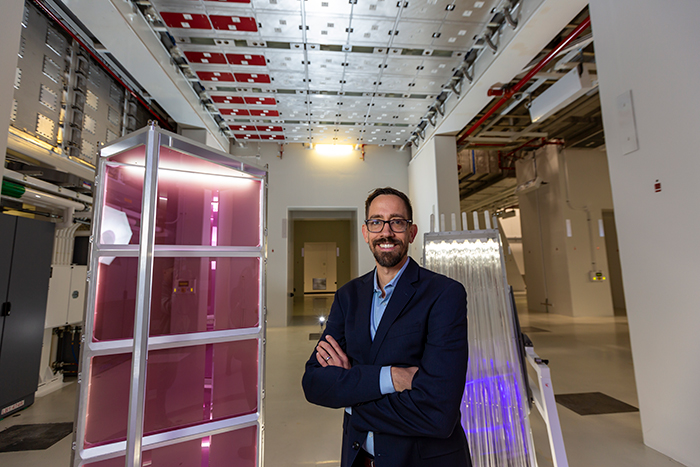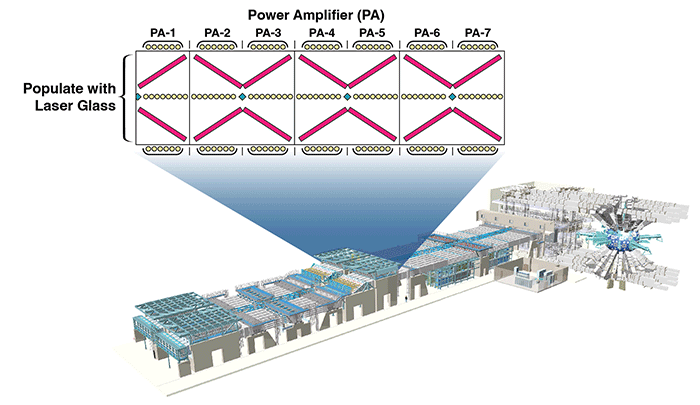
Dayne Fratanduono, deputy NIF director leading the effort for the Enhanced Yield Capability, stands in a critical spot under the NIF beamline. Additional laser glass, to Fratanduono's left, could be added to available space in the beamline, the red squares above, to increase amplification of the laser. Credit: Jason Laurea
Achieving fusion ignition is just the beginning.
“It's an incredible accomplishment—fusion ignition—60 years in the making, dating back to the 1960s when John Nuckolls first proposed that this could be possible with inertial confinement fusion,” said National Ignition Facility (NIF) Director Gordon Brunton. “But this is by no means an endpoint. We can now study new regimes in high energy density physics that are important to our stockpile stewardship mission.”
The only place in the world where fusion ignition has been achieved in a laboratory is NIF, where Lawrence Livermore National Laboratory first achieved ignition on Dec. 5, 2022. Some of the 25-year-old facility's infrastructure is more than 40 years old, but NIF is still the highest energy laser system in the world, with many more productive years ahead. NIF experiments generate data to secure the integrity of America's nuclear weapons stockpile in lieu of weapons testing.
“Recently we pushed the laser energy to 2.2 megajoules (MJ)—pretty good for a laser designed for 1.9 MJ. We believe that with upgrades within the existing footprint of the facility, we could deliver 3 MJ of laser energy,” Brunton said.
Studies using recent ignition experiments indicate such an upgrade in laser energy could increase fusion output by a factor of 10, resulting in yields in the 30 MJ range. Researchers think with new insights and innovative approaches, even higher yields may be realized. A proposal, still in the early stages, could turn this idea into reality.
“From an engineering perspective, the changes we are proposing are straightforward, although that doesn't mean they are simple or easy,” said Dayne Fratanduono, deputy NIF director leading the effort for the Enhanced Yield Capability. “With a modest investment into the NIF, we have solid evidence that we can increase the laser performance by about 40 percent. A small increase in laser energy has been shown to significantly increase the fusion yield. We believe it's an excellent time to upgrade the NIF laser to greatly expand its contributions to national security.”
Since it began operating in 2009, the NIF laser steadily continued to improve in performance, a trend unique among past and current inertial confinement fusion (ICF) lasers. This is the result of sustained investments by the National Nuclear Security Administration (NNSA) supporting world leading advancements in optics and laser technology, coupled to a laser architecture designed to readily incorporate and leverage those investments.
A sustainment plan is underway to ensure that NIF continues to deliver for the Stockpile Stewardship Program through its design lifetime of 2040. The Enhanced Yield Capability project aims to take NIF further.
“Yields of 30 MJ would give us laboratory access to high energy density physics realms that no one has touched before, which would greatly enhance NIF's impact on stockpile stewardship science,” Fratanduono said. “With a 30 MJ facility, we can increase our understanding of operating in this regime to reduce uncertainties to inform design parameters of next-generation high-yield ICF facilities.”
The Enhanced Yield Capability project proposes to take advantage of the way the facility was designed with future enhancement in mind. The power amplifiers, which sit in the middle of the beamline, each have five slabs of neodymium-doped laser glass, but there is space for two more slabs. And LLNL has that laser glass available—surplus from the original production run for NIF construction.

Boosting the beamlines: Adding two additional slabs of laser glass to the NIF power amplifier, PA-1 and PA-2 in the graphic, would boost the amount of energy they give to the laser as it passes through. Credit: Mark Meamber
“We still must process the surplus laser glass, build the line replaceable units that will house them, and install them, but we know it can be done. In 2004, we commissioned four beamlines in this configuration and in 2019 we demonstrated that we could operate the machine at an even higher operating point than today,” Fratanduono said.
Another aspect of the project would be refreshing the Final Optics Assembly (FOA), where the laser is converted from infrared to ultraviolet light before entering the Target Chamber.
Additional hardening of the facility to support higher yield capabilities is another essential element. Running the laser at much higher energy also means more damage to the optics, diagnostics, and other critical equipment.
“With the recent breakthrough in the ICF program, additional modest investments in the National Ignition Facility would transform the capabilities within the Stockpile Stewardship Program. The future is very bright for the NIF,” Brunton said.
News from: https://lasers.llnl.gov/news/enhanced-yield-capability-proposal-aims-to-boost-nif-yield


